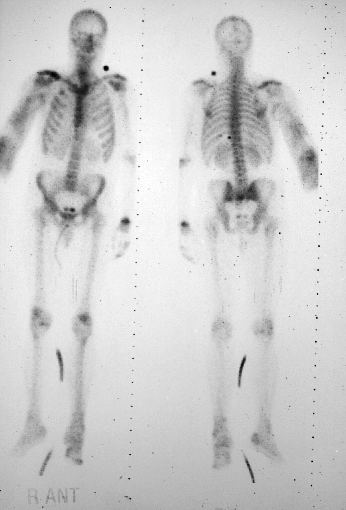Case Author(s): J. Philip Moyers , . Rating: #D2, #Q4
Diagnosis: Diffuse soft tissue activity in a pattern consistent with
a severe electrical injury
Brief history:
Status post trauma
Images:

Anterior and Posterior images from a Tc-99m
pyrophosphate bone scan
View main image(bs) in a separate image viewer
Full history/Diagnosis is available below
Diagnosis: Diffuse soft tissue activity in a pattern consistent with
a severe electrical injury
Full history:
This is a 36-year old man who is
a worker for a local electric company who was
standing next to an electrical truck with his right
hand on the truck when the gantry of the truck hit a
high tension power line. The patient suffered a severe
electrical injury to the right arm with exit wounds at
both feet. The patient was referred for a Tc-99m
pyrophosphate study to evaluate for tissue necrosis
and bone viability.
Findings:
Diffuse soft tissue uptake is
demonstrated in the proximal right arm extending to
just below the right elbow. There is absent activity
demonstrated below the right elbow consistent with
radial and ulnar artery thrombosis due to severe
electrical injury. Increased activity is demonstrated
in both feet. There is, however, decreased activity in
the left great toe.
Discussion:
Common radiopharmaceuticals
include Tc-99m labeled phosphate analogues. These
include Tc-99m pyrophosphate, methylene
diphosphonate, and methylene
hydroxydiphosphonate. Of these agents, MDP and
MHDP have the most rapid blood clearance. Tc-99m
pyrophosphate contains two phosphate residues.
This agent is superior in localization in infarcted
tissues to other bone agents commonly used today.
Common causes of soft tissue uptake of radionuclide
bone agents include metastatic adenocarcinoma such
as breast cancer, GI metastases, and ovarian
carcinoma. Calcification in dystrophic soft tissues or
tumorous calcifications in patients with renal failure
and chronic inflammatory change can also be causes
for soft tissue uptake. Areas of infarction in muscle,
brain, and heart may also be demonstrated on bone
scintigraphy.
References: 1) Mettler FA.
Essentials of Nuclear Medicine Imaging. 1991, 3rd
edition. 2) Datz FL. Handbook of Nuclear Medicine,
Mosby Yearbook Publishers, 1993, 2nd edition.
Followup:
The patient had a right below-the-
elbow, forearm amputation. The patient also had a
left great toe amputation.
Major teaching point(s):
The Tc-99m pyrophosphate
study was requested due to Tc-99m pyrophosphatešs
greater localization in damaged tissues over Tc-99m
MDP. The clinicians were interested in the extent of
tissue necrosis. In this case, the soft tissue activity
extended to the level of the right shoulder. Also, the
lack of activity below the right elbow was consistent
with radial and ulnar artery thrombosis at this level.
The findings on this study were helpful to the
clinicians in that a below-the-elbow amputation was
performed, thus preserving some patient function in
the right arm.
ACR Codes and Keywords:
References and General Discussion of Bone Scintigraphy (Anatomic field:Skeletal System, Category:Effect of Trauma)
Search for similar cases.
Edit this case
Add comments about this case
Read comments about this case
Return to the Teaching File home page.
Case number: bs035
Copyright by Wash U MO

